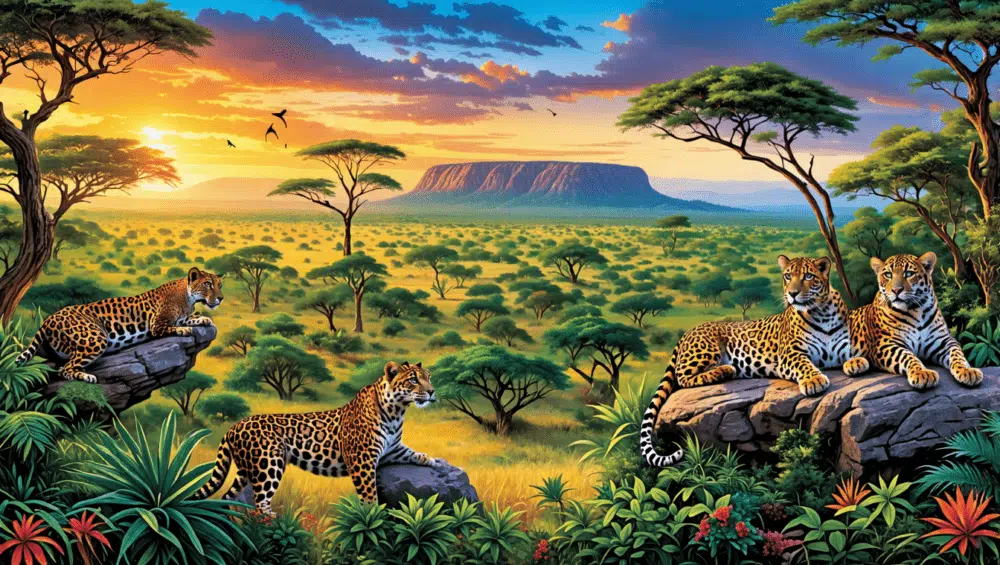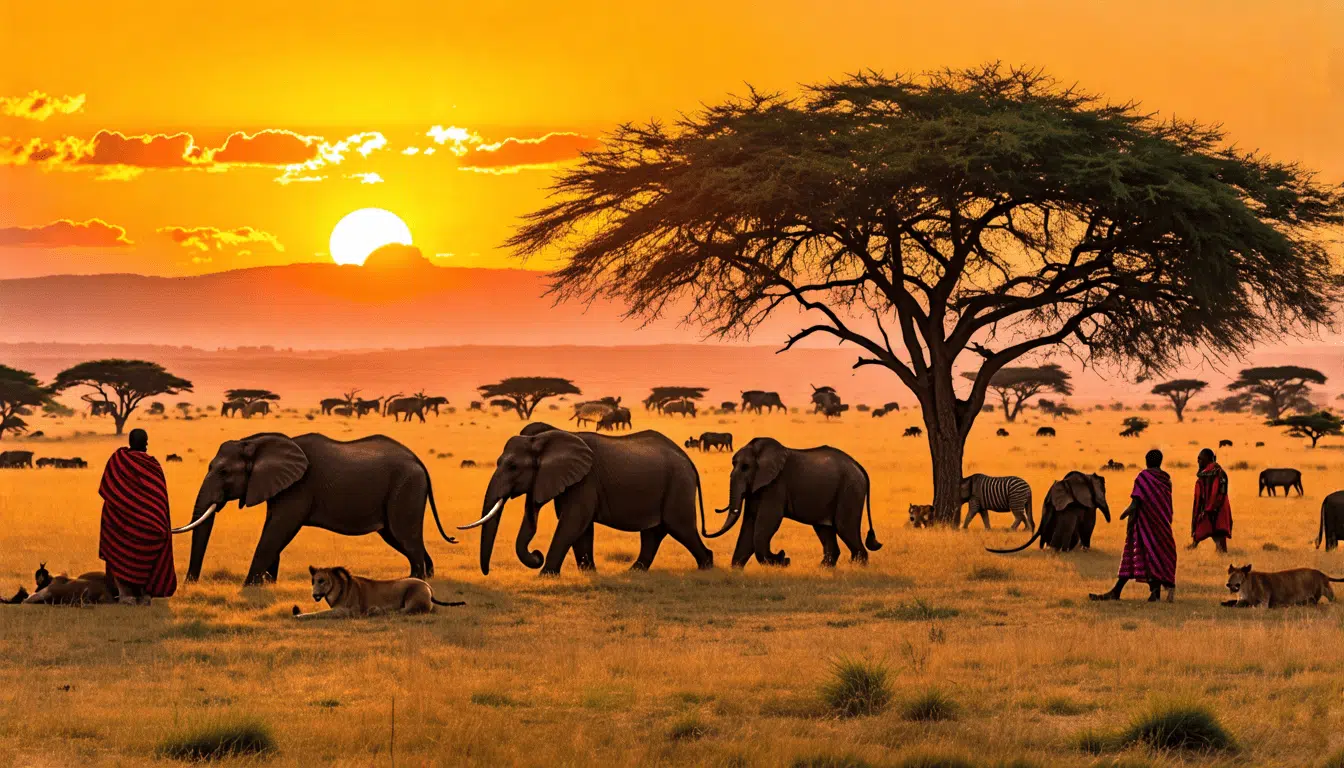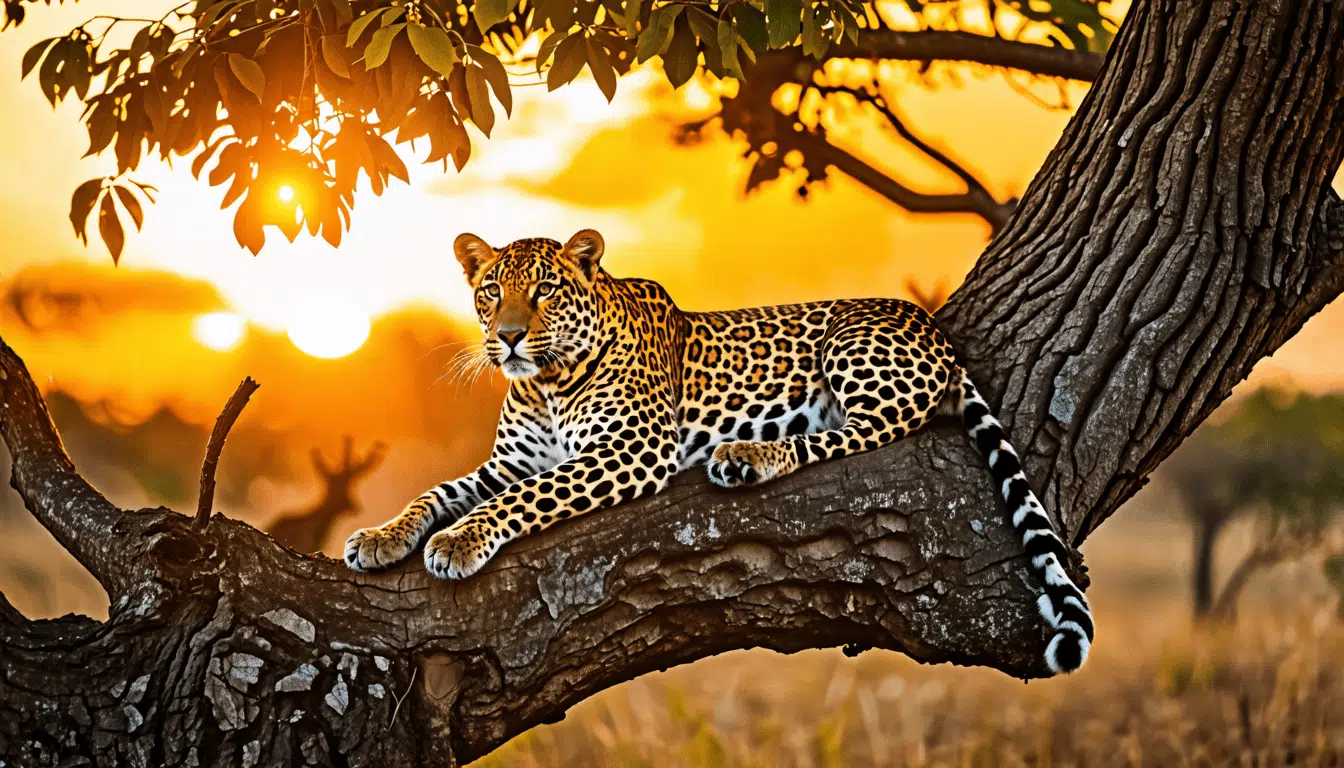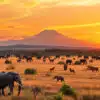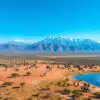Introduction: Why East Africa is a Prime Destination for Leopard Spotting
Have you ever dreamed of locking eyes with a leopard as it glides through the African bush, its sleek figure a testament to the wild elegance only nature can craft? East Africa beckons wildlife enthusiasts with this very promise, owing to its remarkable biodiversity and dedicated conservation efforts. Imagine a place where not only are the landscapes vast and breathtaking, but they’re also ideal settings for a thrilling leopard encounter. Intrigued yet?
East Africa is like a patchwork quilt of stunning terrains, each square teeming with life and adventure. It’s home to savannahs that stretch as far as the eye can see, dense forests hiding secrets of the wild, and rugged terrains that challenge and thrill in equal measure. From the iconic Serengeti National Park in Tanzania to the culturally rich Maasai Mara in Kenya, every nook and cranny of East Africa seems to whisper tales of leopards hidden just around the corner.
Leopards are fascinating creatures, playing a crucial role in the African ecosystem. As top predators, they keep prey populations in check and maintain the intricate balance of life. Their allure extends beyond their ecological importance; these big cats captivate with their beauty and mysterious allure, making them a bucket-list attraction for travelers around the globe. Who can resist the allure of spotting a stealthy leopard poised in a tree, its rosetted coat blending seamlessly with the dappled sunlight?
But, of course, the real magic lies in East Africa’s unparalleled conservation efforts. The region is not just a haven for leopards, but a beacon of hope for wildlife preservation, with national parks and reserves leading the charge in safeguarding these majestic creatures and their habitats. So, are you ready to delve into a safari adventure, meandering through the best spots in East Africa to witness the elusive leopard? Let’s journey together into the heart of leopard country.
Introduction: Why East Africa is a Prime Destination for Leopard Spotting
Who hasn’t dreamed of catching a glimpse of the elusive leopard in its natural habitat? If you’re a wildlife enthusiast, there’s no better place to achieve this dream than in East Africa. Bursting with vibrant biodiversity and remarkable conservation efforts, the region offers a prime stage for witnessing one of nature’s most elusive big cats. But why exactly is East Africa the crowned jewel when it comes to leopard spotting?
The Biodiversity and Conservation Efforts of East Africa
First off, let’s talk about the biodiversity. East Africa is like the Broadway of wildlife—an ensemble cast of big game animals strutting their stuff over vast savannahs, dense forests, and rolling hills. It’s as if Mother Nature threw the ultimate block party here, and everyone, from elephants to flamingos, got an invite.
But all this grandeur wouldn’t remain intact without significant conservation efforts. Many national parks and reserves have taken center stage in preserving these crucial ecosystems. For instance, anti-poaching units and community-driven conservation programs ensure that the delicate balance of the ecosystem is maintained, allowing leopards and other wildlife to thrive. It’s like a never-ending wildlife drama with conservationists playing superhero roles.
The Leopard: A Star of the African Ecosystem
Now, zero in on the leopard itself. Picture a sleek, spotted enigma lurking in the tall grasses or elegantly lounging on a tree branch. Leopards are the introverts of the big cat world—mysterious, solitary, and absolutely iconic. They are vital to their ecosystem, playing the role of both predator and prey in the complex web of nature.
As top predators, leopards help control the population of herbivores, maintaining a healthy balance in the ecosystem. This balancing act supports the flora and fauna diversity that makes East Africa an invaluable destination for wildlife tourism. And let’s admit it; these big cats have a certain allure that can give an Oscar-winning actor a run for their money! Seeing one in its habitat is akin to meeting a celebrity, with every sighting offering an intimate sneak peek into the life of a natural superstar.
Unique Landscapes: Perfect Habitat for Leopards
What makes East Africa a leopard’s paradise apart from spirited conservation efforts and the cats themselves? The landscapes! It’s like the continent handed them a designer home with built-in hunting ranges and panoramic views. From the endless savannas of the Serengeti to the lush greenery of Uganda’s forests, each terrain offers an ideal environment for leopards to roam freely and unseen—perfect for their secretive nature.
Take Tanzania’s Serengeti National Park, for instance, where the flat plains provide vast territories for these leopards to hunt. Or consider the Maasai Mara in Kenya, where the landscape is having an ongoing love affair with wildlife magic, making it an exquisite hotspot for sightings. These terrains don’t just make East Africa prime real estate for leopards; they also provide breathtaking backdrops for our wildlife spectacles. Imagine snapping a photo of a leopard against a golden sunset, or spotting one under the leafy umbrella of a towering tree. It’s the stuff that both Safari enthusiasts and Instagram feeds dream of!
So, what are you waiting for? East Africa’s vast landscapes, incredible biodiversity, and impactful conservation efforts form the trifecta that makes it the best place in the world to see leopards in their natural habitat. Ready your binoculars, pack that sun hat, and get your adventure spirit on, because there are leopards out there waiting to show off their graceful prowess.
Serengeti National Park, Tanzania: The Heart of Leopard Country
Ah, the Serengeti. Just saying the name can spark a sense of adventure in even the most seasoned traveler. Imagine sprawling plains that seem to stretch into infinity, framed by acacia trees and dotted with wildlife as far as the eye can see. Now, consider that this magnificent landscape is not only home to the Great Migration but also one of the best places in East Africa to spot leopards. Intrigued yet?
The Serengeti’s Vast Plains and Diverse Ecosystems
If you’ve ever watched a nature documentary, chances are good you’ve caught a glimpse of the Serengeti. Its diversity is nothing short of spectacular. From open grasslands and savannas to the more rugged stretches of kopjes or granite outcrops, the Serengeti offers varied habitats that leopards find irresistible. These elusive cats are often camouflaged amongst the granite boulders, where they lie in wait, contemplating their next stealthy move.
But where should you focus your search in this 30,000-square-kilometer wonderland? Areas like the Seronera Valley and the Grumeti River are prime spots. When I took my first safari there, I distinctly remember the thrill of spotting a leopard lazily draped over a tree branch, the quintessential image of feline grace and indifference.
Best Times and Locations for Leopard Sightings
You might be wondering, When is the best time to visit for a guaranteed leopard sighting? While nothing in wildlife is ever guaranteed (which is part of the fun), your chances increase significantly in the dry season from June to October. During this time, the sparse vegetation makes it easier to spot these solitary hunters, and the prey congregates near water sources, making for an exciting predator-prey interaction.
Ever tried your luck in the early morning hours or around dusk? Those are magical times to be in the park. Leopards, like most of us, prefer the coolness that comes with the break of dawn or the gentle embrace of evening. They’re most active during these times, and if you’re lucky, you might even catch one in the act of hunting. Talk about a story worth telling at your next dinner party!
Choosing Leopard-Focused Tour Operators and Guided Safaris
So, you’ve decided you’re going on this grand adventure. What next? Sure, you could just wing it, but why not enhance your experience with the guidance of expert-led tours? There are numerous tour operators whose guides seem to possess an almost superhuman gut instinct for where these big cats might roam. And believe me, having a seasoned guide can transform your safari from a ‘good day’ to an ‘unforgettable experience’.
When I was planning my trip, I found that talking to other travelers was invaluable. Many recommended small group tours that offer more personalized experiences. Do your research and look for operators with stellar reviews and a proven track record in ethical wildlife practices. Let’s face it, we all want those Instagram-worthy photos, but not at the expense of disrupting the natural behavior of these majestic animals, right?
Another tip? Opt for safari lodges or camps that are located either inside or very close to the park. The proximity means you’ll spend less time getting there and more time enjoying those prime hours of leopard activity. Plus, who doesn’t want to wake up to the sounds of the African savanna firsthand?
Ultimately, the Serengeti isn’t just about the leopards, despite how effortlessly they steal the show. It’s about immersing yourself in a world where nature takes center stage and reminds you how exhilarating it is to be just another spectator in its magnificent theater. So, are you ready to chase shadows and possibly spot a leopard? The Serengeti is calling!
Maasai Mara National Reserve, Kenya: Rich Wildlife and Cultural Heritage
Imagine a place where the roar of the lion meets the stealth of the leopard, set against the backdrop of savannah sunsets and the ancient rhythms of the Maasai people. That’s the Maasai Mara National Reserve for you—a wildlife lover’s paradise and a cultural jewel of Kenya. Now, if seeing a leopard in the wild is at the top of your bucket list, the Mara should definitely be on your map.
A Glimpse of the Mara’s Wildlife Symphony
The Maasai Mara, with its rolling hills and sprawling grasslands, is home to one of the densest populations of leopards in East Africa. Just imagine driving through this expansive landscape during the golden hour and suddenly spotting that elusive spotted coat lounging in a tree or stalking through the tall grass. It’s a dream come true, isn’t it?
Why is it so ideal for spotting leopards, you ask? Well, it’s a combination of the abundant prey and the diverse habitats ranging from acacia-dotted plains to wild riversides. Leopards thrive in this environment, where food is plentiful, and the terrain offers excellent cover for these stealthy cats to practice their craft.
The Maasai and Their Role in Conservation
When we talk about the Mara, we can’t ignore the Maasai people, whose culture is intertwined with the land. Their traditional lifestyle promotes wildlife conservation—they’ve been stewards of this land long before safari trucks roamed the plains. The Maasai believe in coexisting with nature, and this ethos permeates the way the reserve is managed today.
Many Maasai community projects directly support wildlife conservation efforts. By choosing tours and experiences led by Maasai guides, you’d not only stand a good chance of spotting a leopard, but you’d also be contributing to a sustainable and culturally enriched model of tourism. Plus, these guys really know the ins and outs of the terrain. I mean, who knows the secrets of the bush better than the people who’ve lived there for generations?
Where and When to Spot Those Spots
So, where are the best spots to catch a glimpse of a leopard in the Maasai Mara? To increase your chances, it’s all about timing and location. Early morning and late afternoon are prime times—leopards are most active during these periods, especially around the rivers and forested areas where prey tends to gather.
I remember my guide pointing out these golden times as we sipped our morning coffee, waiting for the first blush of dawn. Sure enough, as the sun rose, the Mara awakened with activity, and a leopard was soon spotted lounging gracefully on a rock—a sight I’ll never forget.
Privately managed conservancies adjoining the reserve can also offer a more intimate safari experience with fewer vehicles and more personalized guidance, increasing your chances of a private leopard encounter.
And here’s a little tip: Consider planning your trip during the migration season. While most eyes are on the wildebeest herds and the dramatic river crossings, leopards often take advantage of the abundance of prey, increasing your chances of a sighting.
And of course, the migration spectacle itself isn’t too shabby, is it?
A Few Must-Knows Before You Go
Before you pack your bags, here are some logistical nuggets to consider. Accommodations range from luxury lodges with sweeping views of the Mara to charming tented camps closer to nature. Many camps offer guided walks and night drives, which can add a whole new dimension to your leopard spotting adventure.
Getting to the Maasai Mara is a breeze, with domestic flights from Nairobi landing right in the heart of the action. Once you’re there, guided safari drives usually start bright and early and can continue into the evening, depending on what you’re up for.
So, are you feeling the pull of the Maasai Mara yet? With its rich tapestry of wildlife and culture, it’s more than just another safari stop—it’s an invitation to experience nature at its most majestic. And with the ever-elusive leopard hiding in those tall grasses, you’re in for an adventure that will leave you speechless. Ready for the ride?
South Luangwa National Park, Zambia: A Hidden Gem for Leopard Enthusiasts
So, you’ve made it this far down the leopard trail, and now you’re probably wondering why South Luangwa National Park is a must-visit spot for leopard lovers. Let me tell you, it’s like that quaint coffee shop that serves the perfect brew but only the locals know about—it’s underrated, yet brimming with delightful surprises. South Luangwa is fiercely growing its reputation as the go-to place for watching these elusive big cats in action.
High-Density Leopard Sightings: Not Just a Legend
Let’s cut straight to the chase—South Luangwa is home to one of the highest densities of leopards in Africa. Incredible, right? Picture this: you’re going on a game drive and, there it is, a sleek leopard lounging in a tree like it owns the world. That’s a sight you can brag about for years! Unlike in more popular parks where you need to squint through binoculars, here, leopards often make an appearance closer than you might expect.
A few years back, I found myself in South Luangwa on a serene evening, wrapped in a light sweater (because, surprising news, Zambia can get chilly at night). I was sipping hot chocolate during a night drive when—bam!—headlights caught a leopard about to stalk its prey. It was the experience of a lifetime, and if I had a nickel for every time someone asked to see the video, I’d be wealthy enough to buy the park! The abundance of leopards here is nothing short of a wildlife enthusiast’s fantasy.
Unique Viewing Opportunities: Walking Safaris and Night Drives
If you’re anything like me, adventure tingles in your fingertips. South Luangwa offers something that is not for the faint-hearted—the legendary walking safari. It’s like walking into a wildlife novel but knowing you’re in safe hands. Imagine tracking leopards on foot with a guide who seems like they have an animal sixth sense. It’s primal, exciting, and utterly unforgettable.
Then there are the night drives. Oh, the night drives! Have you ever seen those wildlife documentaries where everything’s blue and black under the moonlight, and every rustle in the grass could be something eye-popping? That’s a night drive in South Luangwa. Leopards, being nocturnal, often come alive during these drives. With skilled trackers and guides, the chance of spotting a leopard slinking through the shadows is thrillingly high.
Travel Logistics and Accommodation: Making the Most of Your Visit
Alright, let’s get practical for a moment. Planning the logistics can make or break your experience. First up, accommodation. South Luangwa boasts an array of options that cater to every taste—from luxury lodges that have you whispering “wow” with every step to more rustic campsites that let you truly connect with nature. I opted for a cozy lodge with a view that still lives in my dreams: the sunrise cresting over the wild landscape is utterly mesmerizing.
When it comes to booking a safari, timing is everything. The dry season, from May to October, is prime time. The vegetation is sparse, and animals tend to gather around water sources, making wildlife easier to spot. Plus, the weather is less likely to tinker with your plans.
Transportation can be a bit of a journey, but, as the saying goes, the harder you work for something, the more you appreciate it. Most visitors arrive via flight into Mfuwe Airport, which is conveniently close to the park. From there, transfers to lodges are generally easy to arrange.
One last pro tip: tap into local knowledge. Engage with the guides at your lodge or campsite. They know the paths like the back of their hands and have fascinating stories that bring the park alive in ways that’ll captivate even the most casual wildlife observer.
There you have it—South Luangwa is more than a park; it’s an experience carved into the canopies and callings of leopards. It’s a place where the wild meets wonder, and trust me, you wouldn’t want it any other way.
Conclusion: Embarking on Your Leopard Adventure in East Africa
So, there you have it! East Africa stands as a veritable paradise for anyone yearning to catch sight of the elusive leopard. Throughout the plains of the Serengeti, the rich tapestry of the Maasai Mara, and the hidden corners of South Luangwa, there’s no shortage of prime spots to witness these majestic creatures in action. And let’s be honest, who wouldn’t want to experience the thrill of spotting a leopard lounging in a tree or stalking its prey across the savannah?
Diving into these unique landscapes not only fuels our affinity for wildlife but also ties us to a region rich in biodiversity and cultural heritage. The dedication towards conservation efforts here is awe-inspiring, and it’s this collaboration between nature and humanity that ensures the leopard, among other wildlife, continues to captivate us for generations to come. It’s a compelling reminder of the things we cherish globally when it comes to wildlife conservation and our responsibility toward it.
Ready to book your adventure? From choosing the right tour operator to timing your visit perfectly, these little details enhance the magical experience of leopard spotting. And, whether you’re an amateur wildlife enthusiast or a seasoned safari-goer, East Africa’s leopard offerings promise to deliver thrills and chills like no other. After all, have you truly experienced East Africa until you’ve locked eyes with the ‘ghost of the forest’?
So pack those binoculars, brush up on your stalking skills, and prepare for a journey filled with dazzling landscapes and unforgettable leopard encounters. Who knows? Your East African safari might just turn into one of those legendary travel tales you’ll be spinning yarns about for years to come!

